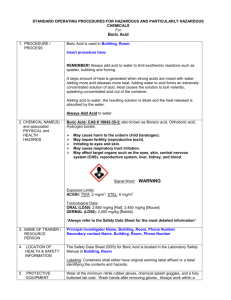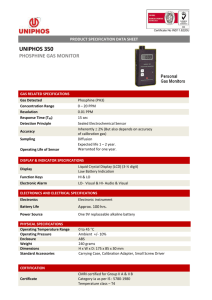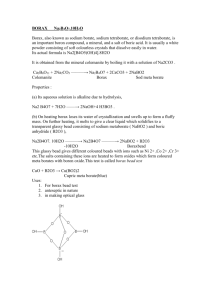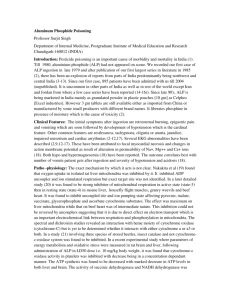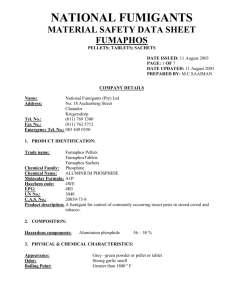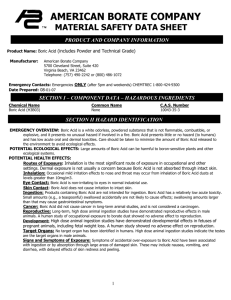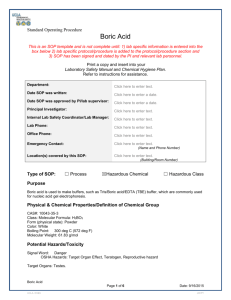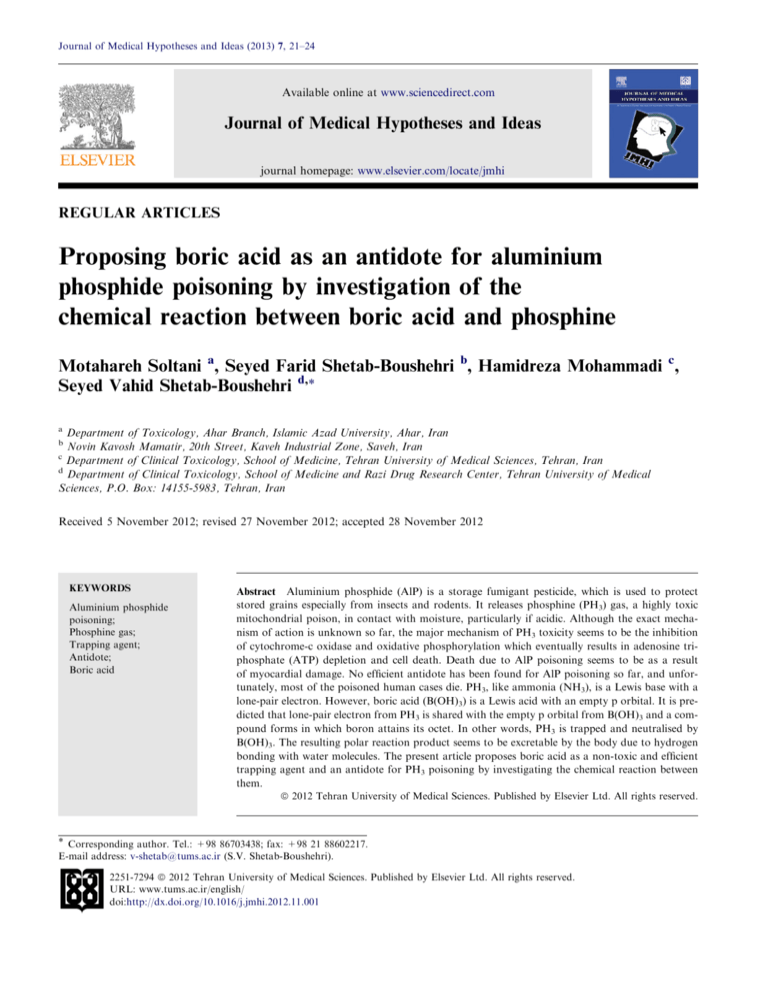
Journal of Medical Hypotheses and Ideas (2013) 7, 21–24
Available online at www.sciencedirect.com
Journal of Medical Hypotheses and Ideas
journal homepage: www.elsevier.com/locate/jmhi
REGULAR ARTICLES
Proposing boric acid as an antidote for aluminium
phosphide poisoning by investigation of the
chemical reaction between boric acid and phosphine
Motahareh Soltani a, Seyed Farid Shetab-Boushehri b, Hamidreza Mohammadi c,
Seyed Vahid Shetab-Boushehri d,*
a
Department of Toxicology, Ahar Branch, Islamic Azad University, Ahar, Iran
Novin Kavosh Mamatir, 20th Street, Kaveh Industrial Zone, Saveh, Iran
c
Department of Clinical Toxicology, School of Medicine, Tehran University of Medical Sciences, Tehran, Iran
d
Department of Clinical Toxicology, School of Medicine and Razi Drug Research Center, Tehran University of Medical
Sciences, P.O. Box: 14155-5983, Tehran, Iran
b
Received 5 November 2012; revised 27 November 2012; accepted 28 November 2012
KEYWORDS
Aluminium phosphide
poisoning;
Phosphine gas;
Trapping agent;
Antidote;
Boric acid
Abstract Aluminium phosphide (AlP) is a storage fumigant pesticide, which is used to protect
stored grains especially from insects and rodents. It releases phosphine (PH3) gas, a highly toxic
mitochondrial poison, in contact with moisture, particularly if acidic. Although the exact mechanism of action is unknown so far, the major mechanism of PH3 toxicity seems to be the inhibition
of cytochrome-c oxidase and oxidative phosphorylation which eventually results in adenosine triphosphate (ATP) depletion and cell death. Death due to AlP poisoning seems to be as a result
of myocardial damage. No efficient antidote has been found for AlP poisoning so far, and unfortunately, most of the poisoned human cases die. PH3, like ammonia (NH3), is a Lewis base with a
lone-pair electron. However, boric acid (B(OH)3) is a Lewis acid with an empty p orbital. It is predicted that lone-pair electron from PH3 is shared with the empty p orbital from B(OH)3 and a compound forms in which boron attains its octet. In other words, PH3 is trapped and neutralised by
B(OH)3. The resulting polar reaction product seems to be excretable by the body due to hydrogen
bonding with water molecules. The present article proposes boric acid as a non-toxic and efficient
trapping agent and an antidote for PH3 poisoning by investigating the chemical reaction between
them.
ª 2012 Tehran University of Medical Sciences. Published by Elsevier Ltd. All rights reserved.
* Corresponding author. Tel.: +98 86703438; fax: +98 21 88602217.
E-mail address: v-shetab@tums.ac.ir (S.V. Shetab-Boushehri).
2251-7294 ª 2012 Tehran University of Medical Sciences. Published by Elsevier Ltd. All rights reserved.
URL: www.tums.ac.ir/english/
doi:http://dx.doi.org/10.1016/j.jmhi.2012.11.001
22
Introduction
Aluminium phosphide (AlP) as a pesticide is present in the
forms of tablet, dust, pellet and grains [1]. In Iran, the tablet
form of AlP is called ‘rice tablet’ because it is used for protection of rice [2]. It reacts with moisture and water and produces
phosphine gas (PH3) [3], a colourless, flammable and highly
toxic gas, with an odour of garlic or decaying fish [4]. Thus,
it is called a fumigant pesticide [5]. AlP is not toxic per se
but the toxic gas PH3, which is formed in contact to moisture,
is responsible for toxicity of AlP [6]. Although the exact mechanism of action is unknown so far, the major mechanism of
PH3 toxicity seems to be the inhibition of cytochrome-c oxidase and oxidative phosphorylation [7], which eventually results in adenosine triphosphate (ATP) depletion and cell
death [4]. AlP is a multi-organ poison. It has toxic effects on
cardiovascular, respiratory, hepatic and gastrointestinal systems and induces acid–base disturbances [7]. Death due to
PH3 poisoning seems to be as a result of myocardial damage
and cardiovascular collapse [8]. Unfortunately, no specific
antidote has been found for routine treatment of AlP poisoning so far and most of the poisoned human cases die [7].
Boric acid (B(OH)3) is a colourless, odourless, transparent
material with a slightly unctuous touch [9]. It has a water solubility of about 50 g l1 (21 C). The pH value of a 0.1 M solution of boric acid is 5.1; thus, it is considered as a weak acid
[10]. Boric acid is considered as a non-toxic material with a
5.14 g kg1 oral median lethal dose (LD50) in rats [11].
Boric acid with an empty p orbital is considered as a Lewis
acid (electron acceptor), which theoretically can react with a
Lewis base (electron donor). A Lewis base has a lone-pair electron that can be shared with empty p orbital of B(OH)3. Boron
attains its octet in the resulting compound [12].
In the present study, the possibility of a reaction between a
non-toxic Lewis acid (boric acid) and a highly toxic Lewis base
(PH3) has been investigated and thus a new antidote for PH3 is
proposed.
Hypotheses/ideas
Reaction between boron triflouride (BF3) and ammonia (NH3)
has been well described long time ago [13–15]. In this reaction,
NH3 as a Lewis base shares its lone-pair electron with an
empty p orbital of a Lewis acid (BF3). Thus, NH3 acts as an
electron donor and BF3 acts as an electron acceptor. After
reaction, the B–N bond has been shown to have a covalent
bond characteristic [13–15]. A similar reaction between
B(OH)3 (Lewis acid) and PH3 (Lewis base) is theoretically expected. It is predicted that boric acid as a non-toxic weak Lewis acid chemically bonds with highly toxic phosphine gas. In
this reaction, phosphine gas is trapped and neutralised by boric acid. The resulting polar reaction product seems to be
excretable by the body due to hydrogen bonding with water
molecules. Thus, boric acid is proposed as a possible efficient
non-toxic antidote for phosphine gas poisoning.
Evaluation of hypotheses/ideas
To evaluate the effectiveness of boric acid to trap and neutralise phosphine gas, the chemical reaction between these two
M. Soltani et al.
substances should be first studied. The volume of released
phosphine gas and the rate of phosphine gas release in boric
acid solution are determined and compared (at the same pressure and temperature) with the condition where boric acid is
replaced with water (control). The pH of the reaction media
will be monitored continuously to evaluate the increase in
pH because PH3 is a base. Addition of hydrochloric acid to boric acid solution and reaching the solution pH to 2 (approximate pH of the stomach) and determination of the volume
of released phosphine gas and the rate of phosphine gas release
will reveal the efficiency of boric acid in trapping and neutralising phosphine in the stomach. Released phosphine will be
collected in and its volume measured by an upside-down
water-filled glass measuring cylinder in a water basin. Rate
of phosphine gas release will be determined by measuring the
produced phosphine gas at appropriate time intervals. To confirm the reaction between boric acid and phosphine gas and
formation of a P–B bond, infrared spectroscopy will be used
using a sodium chloride (NaCl) cell.
Discussion/conclusion
Although digoxin [16], N-acetylcysteine [17], hyperbaric oxygen [18], 25Mg2+-carrying nanoparticles [7], intragastric irrigation with sweet almond oil [19], combination of vitamin C and
methylene blue [20], extensive gastric lavage with coconut oil
and sodium bicarbonate solution with simultaneous aspiration
[21], intra-aortic balloon pump [22], N-omega-nitro-L-arginine
methyl ester (L-NAME) [17], combination of atropine and
pralidoxime [23] and trimetazidine [24] have been reported efficient either experimentally or in case reports, unfortunately, no
specific antidote has been found for routine treatment of AlP
poisoning so far and most poisoned human cases do not survive [7].
The reaction between BF3 as a Lewis acid and NH3 as a Lewis base is schematically depicted in Fig. 1(a). In this reaction,
ammonia and boron triflouride act as an electron donor and
electron acceptor, respectively. The resulting reaction product
is polar with hydrogen bonding with water molecules [12–15].
The reaction between boric acid (B(OH)3 as a Lewis acid
and PH3 as a Lewis base is comparable with the reaction between BF3 and NH3 (Fig. 1(b)). It is predicted that the product
of this reaction is a polar adduct with hydrogen bonding with
water molecules.
Unlike BF3 which is a toxic substance and cannot be used
medically, boric acid is a non-toxic weak Lewis acid [11], which
has several medical uses such as antiseptic, insecticide, eyewash
solution and etc [25]. Although many studies reviewed boric
acid toxicity in humans, most of them have focussed on infants
and children who are inherently susceptible to xenobiotics [26–
33]. A review of acute human exposure to boric acid indicated
that the effects of any particular dose can vary dramatically
among individuals. The average dose for asymptomatic ingestion cases, which accounts for 88% of all ingestions, is around
0.9 g. However, the range of reported asymptomatic doses is
wide, from 0.01 to 88.8 g. The average dose causing symptoms
was 3.2 g, but it was also highly variable with individual values
ranging from 0.1 to 55.5 g. Further, minimum oral lethal doses
of boric acid in humans have been estimated from accidental
poisonings to be in the range of 5–20 g for adults, 3–6 g for
children and <5 g for infants [34].
Proposing boric acid as an antidote for aluminium phosphide poisoning
Figure 1
acid (b).
23
Chemical reaction between boron trifluoride and ammonia (a) and proposed chemical reaction between phosphine and boric
Boric acid does not liberate a proton in water, but rather
bonds to the O atom of an H2O molecule, which then releases
an H+ ion to form the B(OH)4 ion (with a pKa of 9.23)
according to the following chemical equation [10,12–15]:
þ
BðOHÞ3 þ H2 O ! BðOHÞ
4 þH
ðReaction1Þ
The pKa’s of boric acid are 9.24, 12.40 and 13.40, respectively [10]. According to the Henderson–Hasselbalch equation
equation, in the acidic pH of the stomach (about 2.0), almost
all boric acid molecules exist as B(OH)3 [10] and at physiologic
pH of the human body (7.4), about 1.8% of boric acid molecules exist as B(OH)4 and 1.4% of those exist as H2 BO
3.
PH3 is more basic than water; thus, it is predicted that at the
pH of stomach and of blood, a reaction between PH3 and boric acid is more probable.
It has been shown that 500 mg of a 3-g AlP tablet (which
contains about 56% pure AlP (equal to 1680 mg pure AlP))
is lethal for an adult human being [1]. According to the chemical reaction of AlP with water, 1 mol (57.96 g) of AlP produces 1 mol (34 g) phosphine gas [3]:
AlP þ 3H2 O ! AlðOHÞ3 þ PH3 "
ðReaction2Þ
Therefore, it is expected that 500 mg of a 3-g AlP tablet
(equivalent to 280 mg pure AlP) releases 164.13 mg phosphine.
One mole (34 g) of phosphine at standard pressure (1 atm) and
temperature (273.15 K or 0 C) occupies 22,400 ml volume.
Thus, it is expected that under these conditions, 164.13 mg
phosphine occupies 108.13 ml volume. It is predicted that at
normal human body temperature (310.15 K or 37 C), phosphine gas molecules have more energies and hence have more
toxicity than under ambient conditions [12].
According to the following chemical reaction, in the presence of hydrochloric acid of the stomach, a faster reaction occurs [3]:
AlP þ 3HCl ! AlCl3 þ PH3 "
ðReaction3Þ
The proposed neutralisation reaction of phosphine by boric
acid is as follows:
PH3 ðgÞ þ BðOHÞ3 ðaqÞ ! H3 P BðOHÞ3 ðaqÞ
ðReaction4Þ
This reaction seems to be exothermic because an aqueous
solution of an adduct with lower entropy is formed from a
gas (with higher entropy) and an aqueous solution of boric
acid.
According to reactions 2 (occurred in water), 3 (occurred at
stomach pH) and 4, it is predicted that 164.13 mg phosphine
(from 500 mg of a 3-g AlP tablet) is stoichiometrically and theoretically neutralised by 298.47 mg boric acid, which is very
low to poison an adult human. Therefore, the minimum efficient dose of boric acid for neutralisation of AlP and phosphine is proposed to be 1.06 times of the weight of the
former and 1.81 of that of the latter.
According to the following chemical calculation, it is predicted that an absorption peak at about 1029 cm1 due to
P–B bond stretching in the (OH)3B–PH3 adduct appears in
the infrared spectrum [35]:
sffiffiffiffiffiffiffiffiffiffiffiffiffiffiffiffiffiffiffi
sffiffiffiffi
K
ð5 105 Þ
m ¼ 4:12
¼ 4:12
¼ 1029:16 cm1
l
8:013
where m is the frequency in cm1, K is the force constant in
dynes cm1 and l is reduced mass which can be obtained by
following calculation:
l¼
MP MB
30:97 10:81
334:78
¼
¼
¼ 8:013
ðMP þ MB Þ ð30:97 þ 10:81Þ
41:78
where MP and MB are the atomic masses of phosphorous and
boron atoms, respectively.
The reaction of ammonia with boric acid which results in
ammonium borate is another evidence that phosphine gas
can chemically react with boric acid [36].
This article proposes boric acid as a new and efficient antidote for trapping and neutralising phosphine gas by investigating the chemical reaction between these two compounds.
Although the present study predicted that boric acid chemically reacts with phosphine gas, which results in more polar
and may be a more excretable product than phosphine, further
extensive chemical, in vitro and in vivo studies should be done
to show the integrity of the present study.
24
M. Soltani et al.
Overview Box
First Question: What do we already know about the
subject?
There is no specific efficient antidote for AlP and PH3
poisoning so far. Mortality due to AlP poisoning is very
high.
Second Question: What does your proposed theory add
to the current knowledge available, and what benefits does
it have?
Boric acid is a non-toxic Lewis acid which efficiently
traps PH3 gas. In this reaction, boric acid acts as a Lewis
acid and phosphine acts as a Lewis base. The resulted polar reaction product which has H and OH groups can
form hydrogen bonds with water molecules and hence
can be excreted in urine by the body.
Third question: Among numerous available studies, what
special further study is proposed for testing the idea?
The chemical reaction between PH3 and boric acid
should be first studied. The volume of released PH3 gas
and rate of PH3 release in boric acid solution should be
compared (at the same pressure and temperature) with
the condition where boric acid is replaced with water
(control). In vitro and in vivo studies should also be done
to confirm the present idea. Moreover, cytochrome-c oxidase activity in cardiomyocytes and mortality rate should
be determined.
References
[1] Moghhadamnia AA. An update on toxicology of aluminum
phosphide. DARU J Pharm Sci 2012;20:25–40.
[2] Mehrpour O, Singh S. Rice tablet poisoning: a major concern in
Iranian population. Hum Exp Toxicol 2010;29:701–2.
[3] Gurjar M, Baronia AK, Azim A, et al. Managing aluminum
phosphide poisonings. J Emerg Trauma Shock 2011;4(3):378–84.
[4] Mehrpour O, Alfred S, Shadnia S, et al. Hyperglycemia in acute
aluminum phosphide poisoning as a potential prognostic factor.
Hum Exp Toxicol 2008;27:591–5.
[5] Chugh SN, Kishore K, Aggarwal N, et al. Aluminium
phosphide (AlP) is a widely used fumigant posticide. J Assoc
Physicians India 2000;48:855–6.
[6] Misra UK, Tripathi AK, Pandey R, et al. Acute phosphine
poisoning following ingestion of aluminium phosphide. Hum
Toxicol 1988;7:343–5.
[7] Mehrpour O, Jafarzadeh M, Abdollahi M. A systematic review
of aluminum phosphide. Arh Hig Rada Toksikol 2012;63:61–73.
[8] Alter P, Grimm W, Maisch B. Lethal heart failure caused by aluminium phosphide poisoning. Intensive Care Med 2001;27(1):327.
[9] The merck index. New Jersey: Merck & Co., Inc.; 2000
[Whitehouse Station, Monograph number 1364].
[10] Perelygin YP, Chistyakov DY. Boric acid. Russ J Appl Chem
2006;79(12):2041–2.
[11] Smyth HF, Carpenter CP, Weila CS, et al. Range-finding
toxicity data: list VII. Am Ind Hyg Assoc J 1969;30:470–6.
[12] Silberberg MS. Principles of general chemistry. New York,
USA: The McGraw-Hill Companies Inc.; 2010.
[13] Hoard JL, Geller S, Cashin WM. Structures of molecular
addition compounds, III. Ammonium-boron trifluoride, H3NBF3. Acta Cryst 1951;4:396–8.
[14] Hoard JL, Geller S, Owen TB. Structures of molecular addition
compounds, V. Comparison of four related structures. Acta
Cryst 1951;4:405–7.
[15] Lauwbengayer AW, Condike GF. Donor-acceptor bonding. IV.
Ammonia-boron trifluoride. J Am Chem Soc 1948;70(6):2274–6.
[16] Mehrpour O, Farzaneh E, Abdollahi M. Successful treatment of
aluminum phosphide poisoning with digoxin. Int J Pharmacol
2011;7(7):761–4.
[17] Azad A, Lall SB, Mittra S. Effect of N-acetylcysteine and LNAME on aluminium phosphide induced cardiovascular
toxicity in rats. Acta Pharmacol Sin 2001;22:298–304.
[18] Saidi H, Shokraneh F, Ghafouri HB, et al. Effects of hyperbaric
oxygenation on survival time of aluminum phosphide
intoxicated rats. J Res Med Sci 2011;16:1306–12.
[19] Saidi H, Shojaie S. Effect of sweet almond oil on survival rate
and plasma cholinesterase activity of aluminum phosphideintoxicated rats. Hum Exp Toxicol 2011;31(5):518–22.
[20] Soltaninejad K, Nelson LS, Khodakarim N, et al. Unusual
complication of aluminum phosphide poisoning: development of
hemolysis and methemoglobinemia and its successful treatment.
Ind J Crit Care Med 2011;15:117–9.
[21] Bajwa SJ, Bajwa Kaur SK, Kaur J, et al. Management of
celphos poisoning with a novel intervention: a ray of hope in the
darkest of clouds. Anesth Essays Res 2010;4:20–4.
[22] Siddaiah L, Adhyapak S, Jaydev S, et al. Intra-aortic balloon
pump in toxic myocarditis due to aluminum phosphide
poisoning. J Med Toxicol 2009;5:80–3.
[23] Mittra S, Peshin SS, Lall SB. Cholinesterase inhibition by
aluminium phosphide poisoning in rats and effects of atropine
and pralidoxime chloride. Acta Pharmacol Sin 2001;22:37–9.
[24] Dueñas A, Pérez-Castrillon JL, Cobos MA, et al. Treatment of
the cardiovascular manifestations of phosphine poisoning with
trimetazidine, a new antiischemic drug. Am J Emerg Med
1999;17:219–20.
[25] Fail PA, Chapin RE, Price CJ, et al. General, reproductive,
developmental, and endocrine toxicity of boronated
compounds. Reprod Toxicol 1998;12(1):l–18.
[26] Johnsone DE, Basil N. Study on boric acid absorption in infants
from the use of baby powders. J Pediatr 1955;46(2):160–7.
[27] Goldbloom RB, Goldbloom A. Boric acid poisoning: report of
four cases and a review of 109 cases from the world literature. J
Pediatr 1953;43(6):631–43.
[28] Wong LC, Heimbach MD, Truscott DR, et al. Boric acid poisoning, report of 11 cases. Can Med Assoc J 1964;90(18):1018–23.
[29] Baker MD, Bogema SC. Ingestion of boric acid by infants. Am J
Emerg Med 1986;4(4):358–61.
[30] Sanusi ID, Tio FO, Manno JE. Pancreatic inclusions and its
relation to boric acid poisoning: review of the literature and
report of a case. Forensic Sci 1975;6(3):165–74.
[31] Ross CA, Conway JF. The dangers of boric acid, its use as an
irrigant and report of a case. Am J Surg 1943;60(3):386–95.
[32] George AJ. Toxicity of boric acid through skin and mucous
membranes. Food Cosmet Toxicol 1965;3:99–101.
[33] Ducey J, Williams DB. Transcutaneous absorption of boric
acid. J Pediatr 1953;43(6):644–51.
[34] Litovitz TL, Klein-Schwartz W, Oderda GM, et al. Clinical
manifestations of toxicity in a series of 784 boric acid ingestions.
Am J Emerg Med 1988;6(3):209–13.
[35] Pavia DL, Lampman GM, Kriz GS. Introduction to
spectroscopy. London: Brooks/Cole, Thomson Learning; 2001.
[36] Schaller WT. Ammonioborite, a new mineral. J Miner Soc Am
1933;18(1):480–92.

